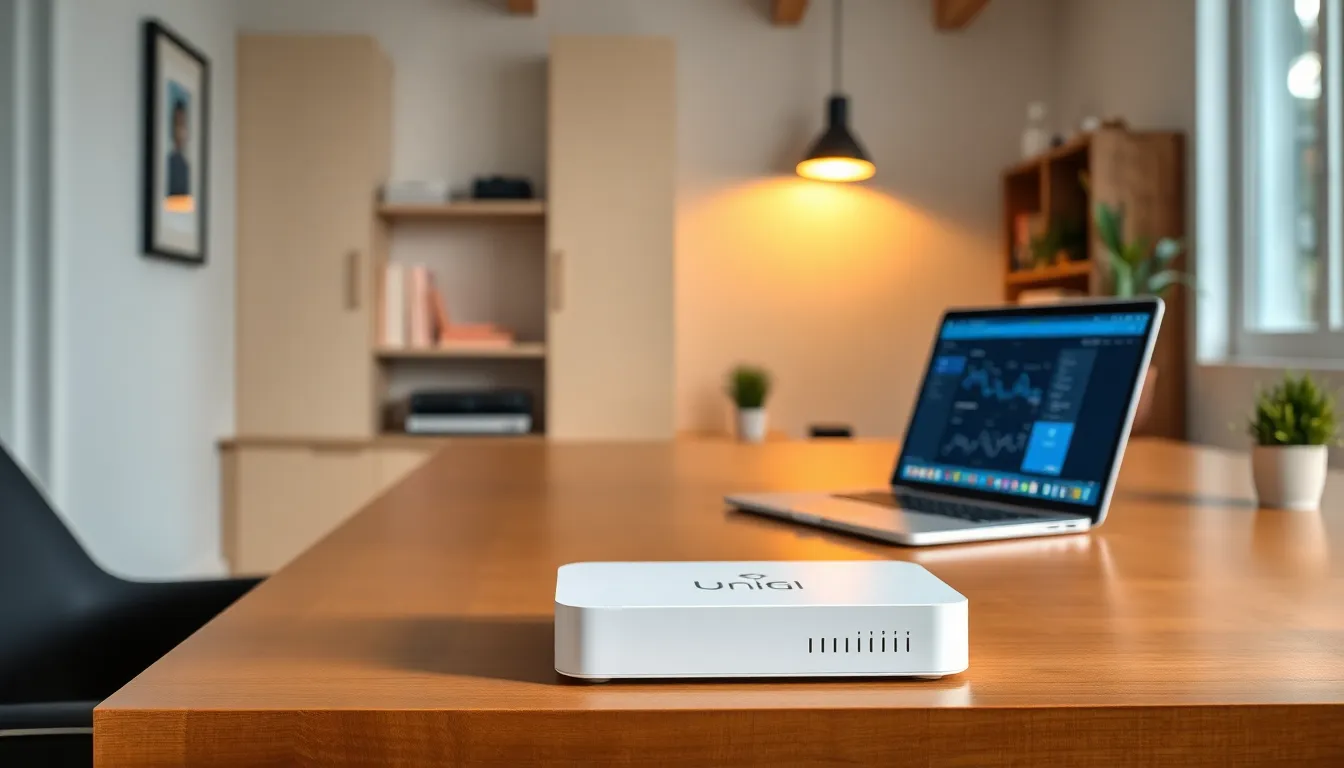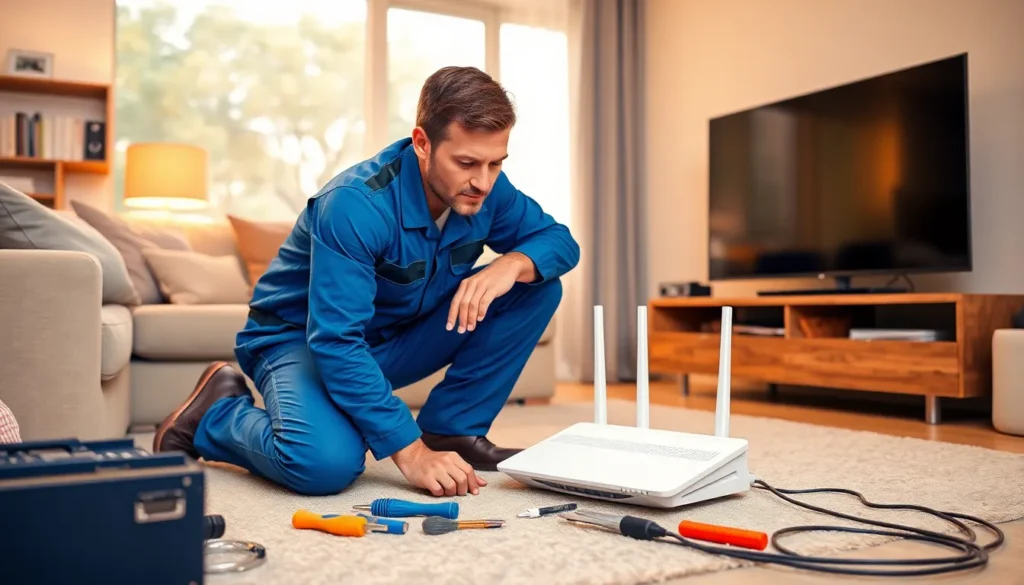Setting up a USG (Unifi Security Gateway) can feel like trying to assemble IKEA furniture without the instructions—frustrating and a little confusing. But fear not! With the right guidance, anyone can transform their home network from a chaotic jumble of wires and signals into a sleek, efficient system that even your tech-savvy friends will envy.
Overview of USG Setup
Setting up a Unifi Security Gateway (USG) involves several key steps that ensure proper integration into a home network. First, he needs to connect the USG to a modem using an Ethernet cable. The modem should provide internet connectivity, allowing the USG to manage network traffic.
Next, access to the USG’s configuration interface is vital. Logging into the web interface requires entering the default IP address into a browser. Once logged in, users can customize settings such as the network name and password, enabling secure wireless access.
Afterward, he can configure WAN settings to optimize internet performance. Selecting DHCP, static IP, or PPPoE as the appropriate WAN connection type facilitates seamless internet access. Specific connection details depend on the Internet Service Provider’s requirements.
Moreover, the security features of the USG can significantly enhance network safety. Enabling firewall settings and creating secure VPN connections adds layers of protection. Users can customize these security features based on individual needs, establishing a robust network infrastructure.
Having completed these initial configurations, monitoring the network performance becomes crucial. Utilizing the Unifi Controller application gives real-time insights into network activity and allows for further adjustments as necessary. Regularly updating firmware ensures the USG operates efficiently, reducing security vulnerabilities.
Ultimately, successful USG setup transforms network management. It empowers users to take control of their home networks, improving connectivity and security. Following these steps leads to an organized and efficient network that meets modern demands.
Benefits of USG Setup

A Unifi Security Gateway (USG) setup carries several advantages for home and small business networks. Users can streamline network management, enhance security, and optimize performance effectively.
Enhanced Efficiency
Enhanced efficiency emerges as a primary benefit of USG setup. Devices connect seamlessly, ensuring faster response times. Configuration options allow tailored settings according to specific needs, such as bandwidth allocation and priority rules. Network reliability improves with the USG’s ability to manage traffic intelligently. Simple monitoring tools within the Unifi Controller provide insights into network performance, enabling quick diagnosis of issues. Regular updates further enhance the USG’s capabilities, ensuring users benefit from the latest features and security patches.
Cost-Effectiveness
Cost-effectiveness stands out as another compelling reason for implementing a USG. This device minimizes the need for multiple network appliances, reducing overall hardware expenses. Investing in a USG often leads to lower monthly costs due to improved bandwidth management, which can decrease unnecessary data overages. Additionally, businesses save on potential IT support by enabling users to manage their networks more efficiently. Energy consumption decreases, as fewer devices result in lower electricity bills. Long-term savings become apparent, making the USG an economically sound choice for network management.
Components of USG Setup
A successful USG setup relies on specific hardware and software components. Understanding these requirements ensures users establish a smoothly functioning network.
Hardware Requirements
The primary hardware component is the Unifi Security Gateway itself, providing essential routing and security features. An Ethernet cable connects the USG to the modem for internet access, ensuring reliable connectivity. Users also require a compatible switch to extend wired connections throughout the network. Wireless access points enhance Wi-Fi coverage, allowing for strong signals across larger areas. Finally, having a UPS (Uninterruptible Power Supply) protects equipment from power outages, maintaining network stability during interruptions.
Software Requirements
Access to the Unifi Controller application is crucial for managing and configuring the USG. This powerful software provides user-friendly interfaces for monitoring network performance. Users need to install the latest firmware updates for optimal security and functionality. Configuring VLAN settings might also enhance network segmentation, improving performance and management. Lastly, a suitable browser ensures seamless access to the USG’s web interface, allowing for straightforward adjustments and setups.
Steps to Implement USG Setup
Executing a successful USG setup involves several crucial steps, each contributing to an efficient home network. Below are key considerations for planning, installation, and configuration.
Planning and Design
Effective planning establishes a solid foundation for the USG setup. Users should assess the network’s coverage area and determine placement for optimal performance. Identifying the number of devices helps in estimating bandwidth requirements for seamless functionality. Mapping out network segments ensures efficient traffic management. Additionally, consider integrating VLANs for enhanced security and organization. Documenting the network layout aids in identifying connections and configurations needed later.
Installation Process
Installing the USG requires methodical attention to detail. Begin by connecting the USG to a modem using an Ethernet cable. Position the USG in a central location for optimal wireless reach. Next, connect any switches and access points as per the designed layout. Ensure all devices are powered on and properly connected. Confirm internet connectivity by testing with a connected device. Following physical installation, proceed to access the USG’s interface for configurations.
Configuration Tips
Configuring the USG effectively enhances network performance and security. Access the Unifi Controller application to begin setup. Establish custom network names and passwords to secure wireless access. Customize WAN settings based on ISP specifications for optimal speed. Enable firewall settings to bolster security against external threats. For secure remote access, create VPN connections within the configuration settings. Monitor performance metrics through the Unifi Controller regularly, ensuring the firmware remains up-to-date for best functionality.
Common Challenges in USG Setup
Setting up a Unifi Security Gateway (USG) presents unique challenges that require attention for a successful installation. Common problems can arise during the process.
Troubleshooting Issues
Troubleshooting issues often surfaces as a significant challenge in USG setups. Users may experience connectivity problems after initial configuration. Diagnosing whether the modem is functioning properly helps pinpoint the issue. Resetting the USG may also resolve persistent problems. Identifying conflicts with existing network devices can enhance connectivity. Reviewing the WAN settings aligns the system with the Internet Service Provider’s parameters. Ensuring the firmware is up to date guards against bugs that can disrupt performance. Each of these steps can lead to a more stable network environment.
Maintenance Considerations
Maintenance considerations play a crucial role in the longevity of a USG setup. Regularly assessing the network’s performance ensures optimal function. Updating firmware consistently protects the network from vulnerabilities. Monitoring connected devices helps identify any unauthorized access attempts. Scheduling routine reboots can mitigate memory leaks and improve performance. Evaluating the effectiveness of firewall settings strengthens security measures significantly. Lastly, users should document configuration changes for reference during troubleshooting. Taking these actions ensures a secure and efficient network operation.
Successfully setting up a Unifi Security Gateway can transform a home network into a powerful and efficient system. By following the outlined steps and utilizing the right tools, users can achieve a setup that not only enhances connectivity but also prioritizes security.
Regular maintenance and monitoring are key to ensuring long-term performance and reliability. With the USG in place, users gain control over their network, allowing for tailored configurations that meet their specific needs. Embracing this technology not only streamlines network management but also delivers significant cost savings over time.













